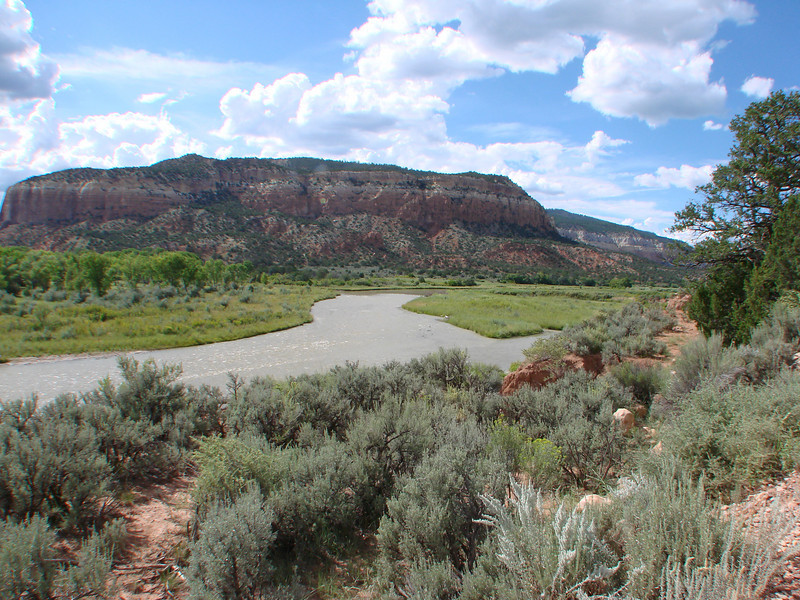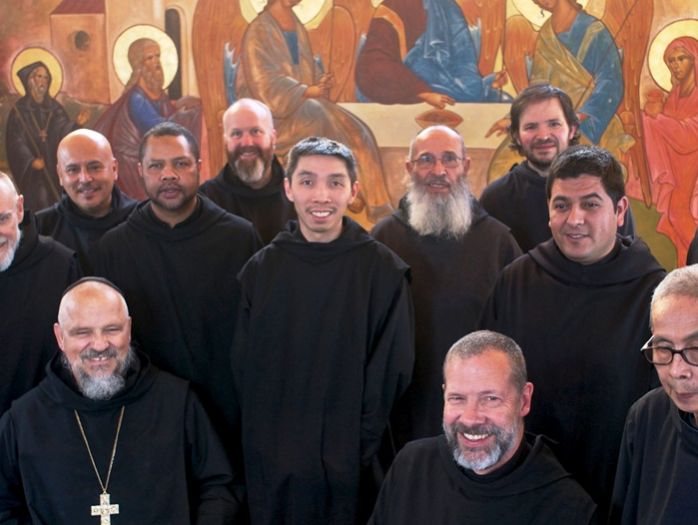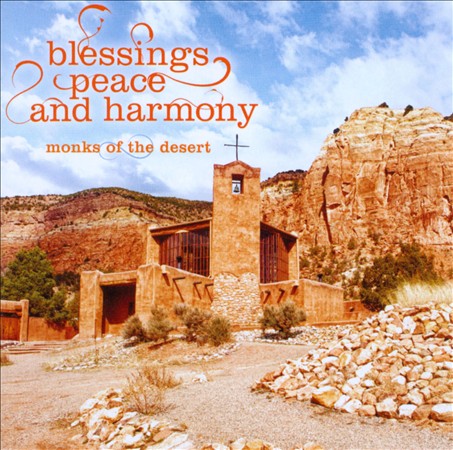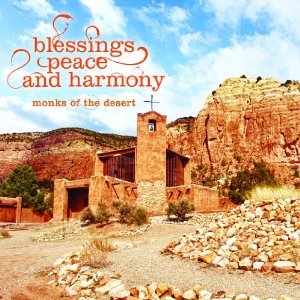The Chama Rivery Canyon Wilderness (Photo: SmugMug)From the Wilderness, Blessings, Peace and Harmony
‘To chant, to sing, engages one’s whole being’: From the New Mexico desert, an American order of Benedictine monks sends a transcendent message in song
In 1978 the United States Congress designated the Chama River Canyon Wilderness and it now encompasses a total of 50,300 acres. All of the wilderness is in New Mexico and is managed by the Forest Service.
The wild, scenic Chama River, popular among river rafters and canoeists, runs through six miles of the Wilderness. Its beauty is so impressive that most people don't bother visiting the relatively unspectacular grassland that dominates the upland portion of the area. Trail access is poor here above the colorful sandstone bluffs and lovely rock formations that rise to high rims on both riverbanks.
Water levels reflect releases from the upstream El Vado Lake Dam, but you can usually float the river, with portages, all the way from the Colorado border to the Rio Grande through the rainbow-hued Chama River Canyon. Backpackers can hike along portions of the Chama River, then pitch their tents in a secluded wooded campsite above one of the canyon's high-water beaches. Trout often flourish in the river (so bring your gear), and onshore residents include mule deer, black bears, elk, coyotes, and mountain lions. Varying canyon elevations also provide a wide range of vegetation, from low-lying pinion-juniper woodland to ponderosa pine and fir. Most of the Wilderness lies in Santa Fe National Forest, with a portion in Carson National Forest.
Monks of the Desert in front of the refectory mural based on a famous icon of the Trinity by the Russian iconographer RublevThe Chama River Canyon Wilderness is part of the 110 million acre National Wilderness Preservation System. This System of lands provides clean air, water, and habitat critical for rare and endangered plants and animals. In wilderness, you can enjoy challenging recreational activities like hiking, backpacking, climbing, kayaking, canoeing, rafting, horse packing, bird watching, stargazing, and extraordinary opportunities for solitude.
It is always our hope that our singing will bring others to peace, inner tranquility and an appreciation of beauty. These values can help create a world in which peace and tranquility prevail.’ –Abbot Philip Lawrence, from his liner notes for Blessings, Peace and HarmonyThe desert can be a place of intense physical and spiritual struggle, though, often leading to greater self-knowledge. In the New Testament the desert wilderness is the place where Jesus encounters the devil, and for centuries it's been home to spiritual seekers, including Christian monastics.
Drive about 75 miles north of Santa Fe and 53 miles south of Chama, and you may be surprised, and your spirit elevated, by the pealing of church bells across the vast, beckoning and seemingly unforgiving landscape. Fourteen years before its Congressional designation as a wilderness, the area’s solitude and spiritually resonate natural beauty drew to it an American order of Benedictine monks from Abiquiu, New Mexico, who founded The Monastery of Christ in the Desert here. All of the buildings were designed by the famous architect George Nakashima. Christ In The Desert was a place where Georgia O'Keefe visited often to paint. Now solar-powered and a recipient of a National Green Award, the facility is surrounded by miles of government-protected wilderness, thus assuring and promoting solitude and quiet for the religious life experienced by men from several nations. Through the ages, singing has been an essential--some say the most essential--aspect of the monastic life, which is spent praying for peace and working and studying in silence. Over the years these Monks of the Desert have recorded four independent albums of Gregorian chant, which until this past April were all unavailable even on the Monks' website. This past April, however, selections from those albums, along with four new chants, were released on CD by Sony Masterworks as Blessings, Peace and Harmony. They have adapted some of the Gregorian melodies to suit the English language, but many of the chants are still sung in Latin. The album was recorded not as you'd expect in the monastery's chapel but in the dining room, which offers better acoustics.
Named after Pope Gregory I, Gregorian chant involves the early Christian liturgical music that originated in medieval times and forms the roots of Western classical music. Consisting solely of melody, the chants are sung unaccompanied and generally by small choral groups--and through the ages have continuously supplied listeners of all circumstances with a soothing sense of solace.
"The kind of singing that we do calms the spirit and helps us live in peace with our world and with one another," says Abbot Philip Lawrence, a scholar of chant who also leads the Monastery of Christ In The Desert. "Chanting has some strange effect on the brain waves according to various studies," continues Abbot Philip, but this effect is certainly not the Monks of the Desert's objective; rather their goal, and that of Gregorian chant, notes Abbot Philip, is "to focus on the words rather than the challenge of voice production or sight reading. It is always our hope that our singing will bring others to peace, inner tranquility and an appreciation of beauty. These values can help create a world in which peace and tranquility prevail."
The unique vibrations from Gregorian chants are not uncommon to mainstream music and can be found in classic works such as Handel's Messiah and Ave Maria. As Abbot Philip suggests, science has discovered various health benefits of chanting. In the late 60s, Alfred Tomatis, a French Physician and specialist in the function of the human ear, conducted an experiment with a Benedictine monastery where the monks were suffering from fatigue and depression. Tomatis discovered that a new decree had halted the usual six to eight hours of chanting the monks had previously observed and, within a short time, the monks were unable to perform their duties. When Tomatis suggested re-instituting their daily chanting, the monks recovered quickly and were able to resume their demanding schedule of work and prayers. Tomatis concluded that chanting actually affects the bones of a human being, stimulated at about 2000 Hz. The sounds of chanting, he concluded, are produced literally from the bones, not the mouth.
Blessings, Peace and Harmony was designed to deliver a solid overall background of Gregorian chant. Approximately two-thirds of the music comes from the Catholic Mass, and is sung in Latin. The Monks of the Desert chose the particular repertoire on the album because it reflects aspects of monastic life throughout the year. The most wonderful aspect of Gregorian chant in a monastic community, concludes Abbot Philip, "is its ability to allow for everyone to sing and yet also provide opportunities for monks who really love music to become more or less specialists. Most of the great monastic choirs have relied on a relatively small number of wonderful voices that are able to sustain the whole choir. Thus, the whole might easily sound better than the individual voices."
Meet the Monks of the DesertThe monks live by the rule of St. Benedict established in the 6th century, with vows of chastity, poverty and obedience. The approximately 35 Benedictine monks who live in the secluded monastery range in age from early 20s to early 90s and hail from from all over the world. Many were professionals and/or scholars before they entered the monastery. One Brother, for example, used to run the National Symphony and Opera of Mexico City; another was an investment banker (he is now in charge of candle making). The three pillars of the monks' lives are reading, working and praying, activities they pursue from 3:45 am. To 7:30 p.m.
The rule of St. Benedict requires the monks to earn their own living, which they do by running a multitude of self-sustaining businesses including light manufacturing, brewing beer (Monk's Ale & Monk's Wit, with a third one in the works--their slogan is "Monk's Ale--Made With Care and Prayer."), an on-site "hotel" and community thrift store in Santa Fe and a separate retail store specializing in hand-crafted religious items, books, music, and folk art. They are the only monastery in the U.S. to have a working on-site brewery. Originally their beer was made off site at a brewery a few hours away but they now are licensed to license to make it on site. They grow the hops on site. The business is run by the monks and a man named Berkeley Merchant, an entrepreneur who gave up his life to help get this monastery and beer off the ground.
The rule of St. Benedict also requires the monks to meet together in the monastery chapel seven times a day and once at night for chanted prayers known as the Divine Office.
"We come to the church throughout the day as a community to pray and sing," adds Brother Christian Leisy. "It's a wonderful expression of joy [or] even sorrow, but of offering one's thoughts and all of one's deeds outside the church to God. One of the best ways to do it in our tradition throughout the ages has been through singing--and not just in the Catholic tradition or even just in the monastic tradition. To chant, to sing, engages one's whole being, really."
Sources:
The Catholic PRWireRadio National, The Rhythm Divine
***
Support the Benedictine Abbey of Christ in the Desert
A statement by Abbott Philip Lawrence:
In keeping with the Rule of Saint Benedict, we balance our life of prayer, study and hospitality with work for our daily bread. Each monastery is expected to be self-supporting. We do not receive financial underwriting from our archdiocese, nor other institutions of the Church, including the Vatican. Over all of the years that I have been at Christ in the Desert, the Lord has provided for us and has never failed us. While God never gives us everything that we want, we really have never lacked what is necessary for our monastic life.We have always insisted that prayer can never be reduced for the sake of work. In our modern world there is a continual pressure to shorten the quiet times of prayer so that we can get more work done. However, we have never seen that as required. Always the friends and benefactors of our community have made our life possible through their prayerful presence, participation and partnership with us.
In a few years, on June 24, 2014, Christ in the Desert will celebrate 50 years since its foundation in 1964. I will turn 70 years old the following day. Those anniversaries form a clear goal for me to aim at. I would love to have all of the earlier construction debt paid off, our physical plant completed and paid for, the foundations independent, and an endowment in place for our future to support a strong and stable community at Christ in the Desert.
The Abbey's most urgent needs at present:
*Help pay the propane bill: We spend about $6,600 per month on the propane that supplements our solar power grid. Until we raise the funds to needed to upgrade our power grid, our propane expenses are a concern for us.
*Complete the fund to upgrade our water system, which is mandated by the state: Though our system is safe, it is inadequate for our current demands. We need to raise about $100,000 more.
At "Supporting Us" on the monastery's website, the full range of the monastery's needs are listed along with various levels of suggested support ranging from $25 on up, along with the complete text of Abbot Philip's statement titled "Financial Reflections from Our Abbot Philip."
Founder/Publisher/Editor: David McGee
Contributing Editors: Billy Altman, Laura Fissinger, Christopher Hill, Derk Richardson
Logo Design: John Mendelsohn (www.johnmendelsohn.com)
Website Design: Kieran McGee (www.kieranmcgee.com)
Staff Photographers: Audrey Harrod (Louisville, KY; www.flickr.com/audreyharrod), Alicia Zappier (New York)
E-mail: thebluegrassspecial@gmail.com
Mailing Address: David McGee, 201 W. 85 St.—5B, New York, NY 10024






